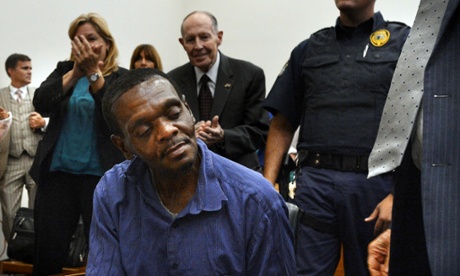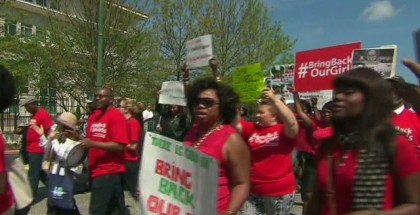Man freed from death row: ‘No anger in my heart’
konknaijaboy | On 04, Sep 2014
(CNN) — Henry McCollum and Leon Brown walked out of prison free men Wednesday after DNA evidence implicated someone else in the rape and murder of a North Carolina child some 30 years ago.
McCollum, 50, was 19 at the time of his arrest. He was sentenced to death in 1984 and was North Carolina’s longest-serving death row inmate. His half-brother, Brown, who is four years younger than McCollum, was initially sentenced to death as well but later had it reduced to life in prison.
“Ain’t no anger in my heart. I forgive those people,” McCollum told reporters, CNN affiliate WRAL reported.
“I don’t like what they done to me and my brother because they took 30 years away from me for no reason, but I don’t hate them,” he said.
WRAL reported that McCollum left Central Prison, in Raleigh, while Brown left Maury Correctional Institution in Greene County, North Carolina.
The siblings were just teenagers when they were arrested in 1983 and charged with the rape and murder of 11-year-old Sabrina Buie in Red Springs, about 30 miles southeast of Fayetteville in rural Robeson County.
Buie’s body was found in an area of Red Springs known as something of a “lovers’ lane,” according to Joe Freeman Britt, the district attorney who prosecuted them in the ’80s. The ground was littered with “beer cans, condoms and cigarettes,” Britt said.
It was one of those cigarette butts that ultimately set the men free.
DNA found on a cigarette “matched another individual named Roscoe Artis, a convicted rapist and murderer who lived less than 100 yards from where the victim’s body was found,” said a statement from McCollum’s and Brown’s attorneys.
Artis is serving a life sentence in a North Carolina prison on a separate conviction. It was not immediately clear whether prosecutors would bring charges against him for Buie’s murder.
US inmates exonerated after 30 years: five questions police must answer
Henry McCollum and Leon Brown have been cleared in North Carolina after decades in prison. Attention now turns to the initial investigation that put two innocent teenagers away
Henry McCollum, North Carolina’s longest-serving death row inmate, and his half-brother Leon Brown were released after more than 30 years in prison on Tuesday after DNA tests proved their innocence of rape and murder. The exoneration followed dogged investigations by the two men’s lawyers and by the North Carolina Innocence Inquiry Commission, an independent body that operates with the full statutory powers of the state.
The exoneration and release of the two men now puts the spotlight on the police department in Red Springs, North Carolina, that carried out the initial investigation leading to the 1984 convictions of the then teenagers and their subsequent languishing behind bars.
James Payne, Leon Brown’s attorney, told the Guardian that in his view the main mistake made by the police was that “they jumped to the first and easiest target without critically investigating the case. That’s who these two boys were – the easiest target, and here we are 31 years later.”
Here are five questions the police authorities in Red Springs now have to answer:
1. Why did the Red Springs police department consistently deny that it had any evidence in its possession relevant to the murder convictions of McCollum and Brown? Only last month the commission found a box full of physical evidence being held by the police that had been in the department’s possession since the early 1990s.
2. Why did the Red Springs police department consistently fail to disclose to lawyers for the two men or to the local district attorney’s office that detectives had requested a potentially critical fingerprint test just days before the 1984 McCollum-Brown trial? The test would have compared the print found on a beer can at the crime scene with the fingerprints of Roscoe Artis, a convicted sex offender and murderer who lived just feet away from the field in which the body of the victim, Sabrina Buie, was found. Neither the request for the test, nor the fact that it was cancelled a year later before being completed, was ever disclosed.
3. Why was the crime scene investigator, who knew all the details of the crime scene as well as key findings from the autopsy of the victim, involved in the interrogation of McCollum, thus risking that his “confession” would be contaminated?
4. Why did detectives write out confessions for both Brown, then 15, and McCollum, then 19, and ask them to sign the statements? Why did they do so knowing that the confessions were incriminating, that the boys were both intellectually disabled and that they were being interrogated in the absence of any legal representation?
5. Why did the police continue to pursue McCollum and Brown knowing that key elements of their confessions were inconsistent with each other? In their “confessions” the two boys incriminated three other youths as accomplices, and yet when the police investigated those three individuals they found they had watertight alibis and were never prosecuted?
Sources: The Guardian; CNN













